4. Communicating with Electors – Report on the 43rd General Election of October 21, 2019
Recent elections in western democracies have taken place in an evolving communications environment that includes increasing concerns about online disinformation and misinformation.
During the 43rd general election, Elections Canada used its various communication channels to share accurate information about the electoral process. The agency's approach emphasized providing electors with all the information they needed to register and vote. Additional efforts were made to reach audiences who faced known barriers to participating in elections: specifically, Indigenous electors, youth, new Canadians, and people with disabilities.
Underlying Elections Canada's communications efforts was an aim to build and maintain the trust of Canadians, and to position the agency as the official source of information about registering and voting.
4.1. Voter Information Campaign
Elections Canada's 2019 Voter Information Campaign was the central element of the agency's efforts to communicate with electors about the general election. Part of Elections Canada's mandate is to make sure that all eligible electors can exercise their democratic right to vote. To achieve this, Elections Canada ran a national multimedia information campaign before and during the election, to provide Canadians with all the information they needed on when, where, and ways to register and vote.
Multimedia campaign
The completely revamped campaign, which started on June 15, 2019, was designed to align with the new pre-election period, which began on June 30.
The pre-election component of the campaign was delivered exclusively through digital platforms and focused on ways to participate in the federal election, including working at the election and registering to vote.
One of the key objectives of the pre-election campaign was to reduce the registration gap for electors aged 18–24. In 2015, 72 percent of electors in that age group were on the preliminary lists of electors, compared to 92.7 percent of all eligible electors (overall coverage). This means that a significant number of young electors did not receive a voter information card providing them with the same basic voting information provided to other electors.
One of the ways that the agency attempted to address this issue was through the use of social media influencers. This had been known to be an effective promotional tactic to reach youth and has been used in many other Canadian jurisdictions by election management bodies. In February 2019, the plan to produce a video featuring social media influencers as part of the pre-election campaign was presented to the Advisory Committee of Political Parties. As social media influencers were being considered for use in the video, regular vetting was performed to rule out those who were not appropriate based on their past activities, including evidence of partisan statements or activities. After some criticism related to the initiative, the agency performed a final vetting process. This final vetting revealed that some past activities of influencers that were not captured previously, could be perceived as partisan. The video therefore posed an unacceptable risk to the agency's core pillars of nonpartisanship and neutrality, and the Chief Electoral Officer decided to remove it from the pre-election campaign.
The election period campaign had four phases with distinct focuses: registration, voter information card awareness, early voting options, and election day.
Overall, the pre-election and the elections period campaigns included advertisements on 28 English and 27 French mainstream television stations, nine ethnic and two Indigenous television stations, in more than 500 daily and weekly publications, on 723 mainstream radio stations, and more than 100 ethnic and Indigenous radio stations. There were also out-of-home elements to the campaign, including advertisements on 3,000 digital public transit screens (e.g. at bus and subway stations) and 2,250 movie screens.
The Voter Information Campaign was also highly visible on several digital platforms, including social media platforms such as Facebook/Instagram, Snapchat, Google/YouTube, and Twitter, and multiple websites.
The multimedia campaign positioned Elections Canada as the official source of information on registering and voting, and directed electors to elections.ca and to the agency's toll-free number for additional information.
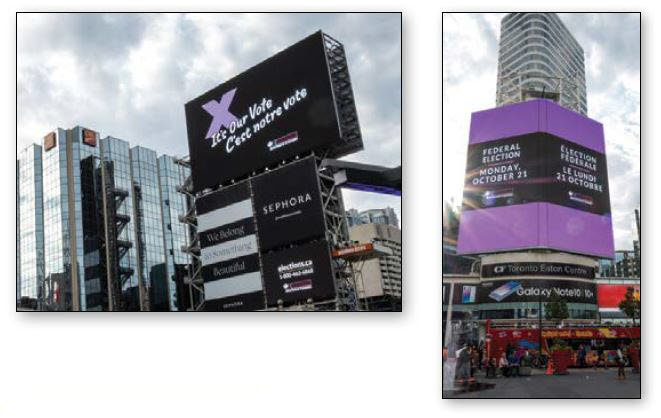
Text version of "Digital campaign billboards in downtown Toronto"
General election website
Elections Canada provided election information on its website (elections.ca) earlier than it had in past elections, to align it with the new pre-election period. On September 11, the agency's homepage adopted the look and feel of the Voter Information Campaign and put essential information for electors up front. The online voter registration service and the Voter Information Service were prominently visible, to allow electors to use the registration service and use their postal codes to find out when and where they could vote, and obtain information on the accessibility of their polling places. The Voter Information Service received five million visits during the election period.
The website aimed to provide information on when, where, and ways to register and vote. It received a record 16.4 million visits during the election period, with 4.1 million visits on election day alone. Increasingly, electors are using their mobile devices to access the Elections Canada website. On advance polling days and election day, mobile users accounted for 77 percent of visits to the website, compared with 61 percent in 2015. Live election results were published online, starting at 7:00 p.m. Eastern time on October 21, with the results page on Elections Canada's website receiving more than 780,000 visits over two days.
Social media and collaboration with digital platforms
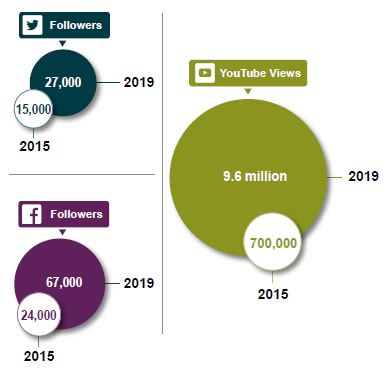
Text version of "Social media growth"
As part of its overall communications efforts, Elections Canada worked with digital platforms Google/YouTube, Facebook/Instagram, Snapchat, and Twitter to produce more than a dozen online initiatives with the goal of driving electors to elections.ca and online registration. The Facebook registration reminder (September 16 to 21) generated 988,222 visits to the online registration service. Registration activity that originated from Facebook led to 474,495 confirmations, additions, and updates. Facebook's reminder on election day and the night before made Facebook the top referrer to Elections Canada's home page on October 21, surpassing Google as the agency's top driver of election-day traffic.
Elections Canada also collaborated with Google to make sure that people searching for voting information on that search engine were directed to elections.ca. During the election period, up-to-date information about when and ways to register and vote appeared directly on google.ca.
Elections Canada also leveraged its work with social media platforms to address instances of incorrect information.
Elections Canada also used its corporate social media accounts to interact with the public. Between September 11 and October 22, Elections Canada received 44,667 messages through its accounts and responded to 2,696 enquiries.
Direct mail
As in past elections, the voter information card (VIC) played a crucial role in providing information about the electoral process. A VIC was mailed to each registered elector to provide personalized information on when and where to vote, the accessibility of the polling place, and how to contact the nearest Elections Canada office. The agency mailed 26.2 million VICs by September 27 to electors whose names appeared on the preliminary lists of electors. It subsequently mailed about 209,000 revised VICs to advise electors of changes to polling place information and about 1.1 million VICs to electors who were newly registered or had updated their names or addresses.
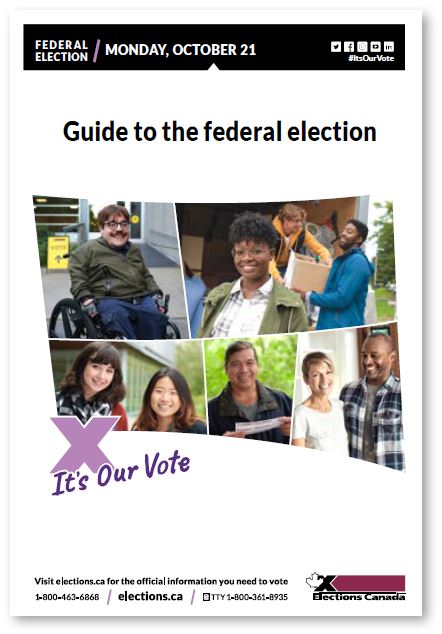
Text version of "Guide mailed to every Canadian household"
A week after sending the VICs, Elections Canada distributed the Guide to the federal election to every household in Canada. The brochure provided information about voter eligibility, registration, ways to vote, identification requirements (including information about accepted pieces of identification), accessibility of polling locations, and voting assistance tools and services available on election day. It also prompted electors to contact Elections Canada if they had not received a VIC. The agency distributed 15,424,443 bilingual brochures across Canada and an additional 10,073 trilingual brochures in Nunavut.
Media relations
Elections Canada organized a technical briefing for journalists on June 11, before the new pre-election period began, to provide information and answer questions about the changes to the Canada Elections Act that were brought about by the passage of Bill C-76.
During the pre-election period and the election period, the media relations team answered 4,317 requests from journalists. During the pre-election period, they answered 488 requests. The remaining 3,829 requests were answered during the election period, which is comparable to past general elections.
Once the writs were issued, Elections Canada used its network of 12 regional media advisors and its permanent media relations advisors to provide information about all aspects of the electoral process to local, national, and international media. The Chief Electoral Officer also held a press conference on September 17 to answer questions from journalists and raise awareness about the electoral process.
The vast majority of the 3,829 queries from journalists during the election period concerned routine matters of election administration, such as candidate nominations, ways to vote, identification requirements, advance polls, voter turnout, and the Canada Elections Act. More specific to this election were questions about recent modifications to the Act, including changes for international electors.
Elections Canada also initiated calls to the media to provide information on the electoral process. It issued 18 news releases and advisories in both official languages. The media relations team also proactively reached out to media to increase awareness of the agency's efforts to hire election workers.
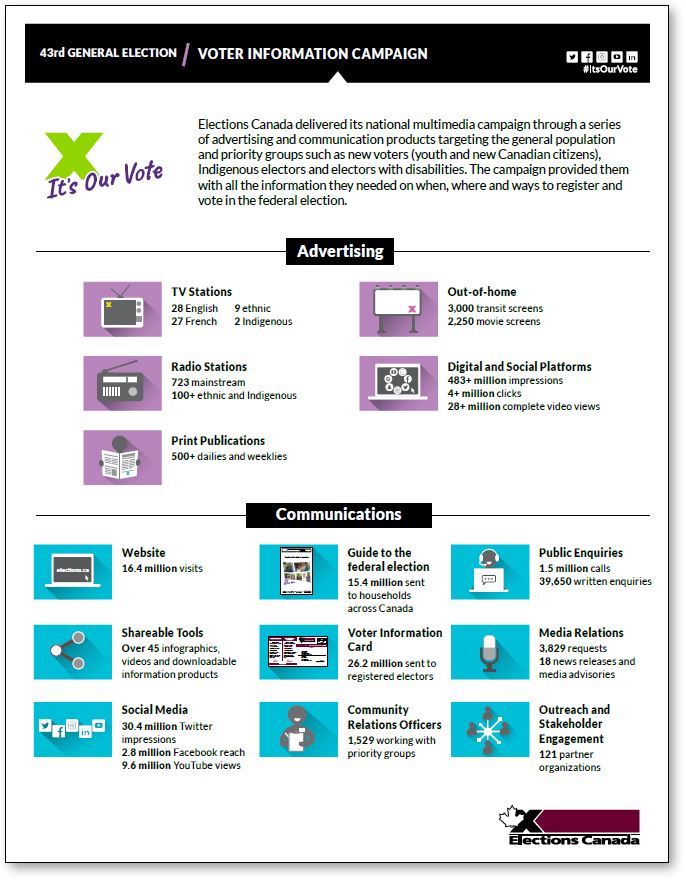
Text version of "Overview of the Voter Information Campaign"
4.2. Outreach and Stakeholder Mobilization
National outreach
In advance of the election, the Inspire Democracy program at Elections Canada negotiated 30 contracts and 91 informal agreements with stakeholder groups. These organizations had the capacity and reach to share information with elector groups that face barriers to registering and voting. These included organizations representing Indigenous electors, youth, new Canadians, and electors with disabilities.
The organizations distributed Inspire Democracy learning materials and shared Voter Information Campaign materials in print, digital, and alternative formats such as braille and large print. They also leveraged Elections Canada's translation of these materials into Indigenous and other languages by delivering these products to communities that would use them.
Contractors and organizations that had informal agreements with Elections Canada also assisted with coordinating or hosting face-to-face outreach events with target groups. Elections Canada head office staff delivered presentations to target groups at 51 stakeholder events across the country. These organizations in turn delivered similar presentations at 195 community outreach events.

Text version of "Outreach resources distributed by stakeholders"
Local outreach
Community relations officers
This election saw new opportunities for community relations officers to serve additional elector groups that might also face barriers to registering and voting. These new groups included Métis communities, minority official language communities, and, in light of the fact that election day and some advance polling days coincided in 2019 with holidays during which observant members of the Jewish community could be prevented from voting, communities with significant Jewish populations.
Community relations officers delivered information to these and other target groups locally. Approximately 23,385 electors visited kiosks set up by community relations officers and an estimated 7,572 electors attended presentations. Community relations officers also hosted discussion groups, distributed information products, and liaised with administrators of relevant organizations or facilities.
During the planning for this general election, returning officers were given the opportunity to hire community relations officers to conduct outreach activities with Indigenous communities within their electoral districts, whether on a First Nations reserve or in an urban area with a large Indigenous population. Appointing a community relations officer was also encouraged if there were Inuit or Métis communities within the electoral district.
Returning officers hired a total of 1,529 community relations officers for the 2019 general election, compared with 1,201 for the previous general election. They hired more community relations officers, with the exception of those working with electors with disabilities and those working with homeless electors. This will be further discussed in upcoming reports.
Table 4 in the Appendix lists the number of community relations officers hired by category.
Further outreach to Indigenous communities
As in the past, returning officers hired elders and Indigenous youth to work at polling places on election day to help explain the voting process, answer general questions, and provide interpretation services.
Elections Canada also launched the Elector Services in Remote Indigenous Communities (ESRIC) pilot project over the 18 months leading up to the election. Based on specific criteria, certain remote Indigenous communities in 26 electoral districts were identified to participate in this pilot project. This project focused on building stronger relationships to better understand and respond to the needs of electors in these communities. Returning officers were provided with resources to conduct pre-election outreach to these Indigenous communities. The returning officers' outreach depended on local context; activities included attending local events, presentations to chiefs and councils on voting options, visits to band administrators, election information booths at community events, and outreach tailored to each community.
Once the election was called, all returning officers with Indigenous communities in their electoral district were sent Voter Information Campaign products for their community relations officers' outreach efforts, including selected products in local Indigenous languages.
All outreach activities to Indigenous communities will be analyzed in the upcoming retrospective report.
Civic education
The 2019 general election presented an important opportunity for Elections Canada to fulfill its role of educating elementary and secondary students. To increase future electors' understanding of the electoral process, Elections Canada engaged the registered charity CIVIX to deliver a parallel election, called Student Vote Canada 2019. This program, which has been offered during federal elections since 2004, achieved its highest level of participation ever. More than 1.1 million students in all electoral districts cast ballots, a 29 percent increase over 2015.
Though Student Vote Canada 2019 was the main educational focus during the election period, Elections Canada also made its own learning resources available to teachers. Over 3,000 educators requested these curriculum-linked resources, an increase of 64 percent over 2015.
4.3. Complaints
Elections Canada always welcomes feedback from Canadians on all aspects of the electoral process. Complaints can be lodged through a newly redesigned online form, by telephone, by email, or by regular mail. During the election, electors could also file a complaint at an Elections Canada office or at their polling place.
A total of approximately 19,000 complaints were received from members of the public, election day workers, political entities, suppliers, election administrators and field office staff from June 30, 2019, to December 1, 2019, a period that covers the pre-election period, the general election period, and the immediate post-election period.
Complaints received from the start of the election period on September 11 through to December 1 totalled about 11,100, down from 17,000 in the comparable period for the 42nd general election.
Complaints by category
Freedom of expression and climate change
Elections Canada received about 6,700 complaints related to issues around freedom of expression and climate change in the context of third-party advertising rules (further described in Section 5.1 of the report). Nearly all of those complaints were submitted during the pre-election period (June 30 to September 10).
Voter experience and services to electors
Elections Canada received nearly 5,000 complaints about the voter experience or services to electors, whether at the polls, online, or through any other service channel.
These complaints touch on many Elections Canada products and services, particularly the experience at the polls (e.g. wait times, election worker conduct, official languages, voting procedure, and accessibility of services), experience using online tools (e.g. registration or finding a polling place) and experience receiving services by mail (e.g. voter information card or special ballot).
Accessibility
As of January 8, the agency received about 2,400 complaints about the accessibility of polling locations and Elections Canada offices. The top four issues identified in these complaints are related to parking, location of the polling station inside a building, signage and level access entrances. Table 5 in the Appendix provides a detailed breakdown of complaints.
Candidates and political entities
The agency received approximately 1,500 complaints about candidates and political entities. These included cases where a candidate or political entity was the subject of the complaint, or where products, services or rules related to candidates and political entities were the subject of the complaint.
Most complaints were from members of the public, and were related to campaign and political advertising activities such as campaign sign posting, campaign phone calls, campaign text messages and online media (including social media).
Polling day worker or election administrator experience
The agency received 1,400 complaints about the experiences of individuals applying to work for Elections Canada during the general election or employed as election day workers or election administrators. About half of these complaints were about pay. The remaining complaints mostly referred to working conditions (e.g. working without breaks, quality of training) and to hiring (e.g. complaints about the application process or not being hired).
Canada Elections Act and policies
Elections Canada received approximately 1,300 complaints related to the Act and its policies. This excludes complaints related to free expression and climate change which were counted separately due to their high volume in the 2019 general election.
The complaints in this category were typically questions related to voter eligibility and proof of identity, acceptable conduct for election workers, candidates and electors, and laws and regulations on advertising and media.
Other
An additional 955 complaints were too generic or did not contain enough data to be categorized.
Complaint management
Complaints were given the highest priority when an individual's right to vote was at stake. Complainants whose right to vote may have been affected were often dealt with immediately by providing the address of the polling place or the telephone number for the returning officer.
Complaints related to a potential offence under the Canada Elections Act were referred to the Commissioner of Canada Elections for further investigation. Complaints related to potential offences involving robocalls or other voter contact services were referred to the Canadian Radio-television and Telecommunications Commission.
As was the case in 2015, it is expected to take approximately five months to respond to all complaints from the 2019 general election. As complaints are closed, their categorization or the number of complaints may change once more details about each complaint are understood. Further analysis will be provided in the retrospective report.
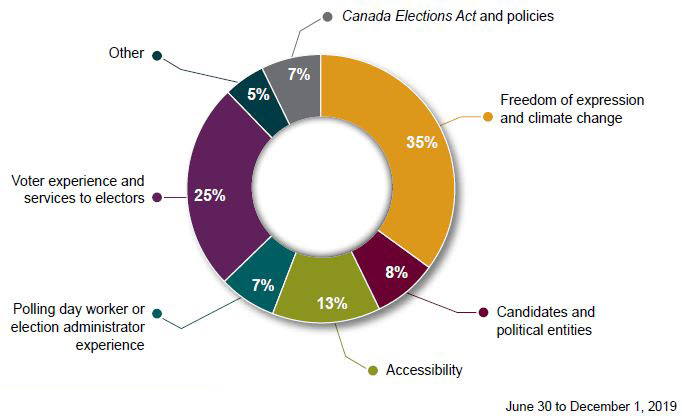
Text version of "Complaints by category"
